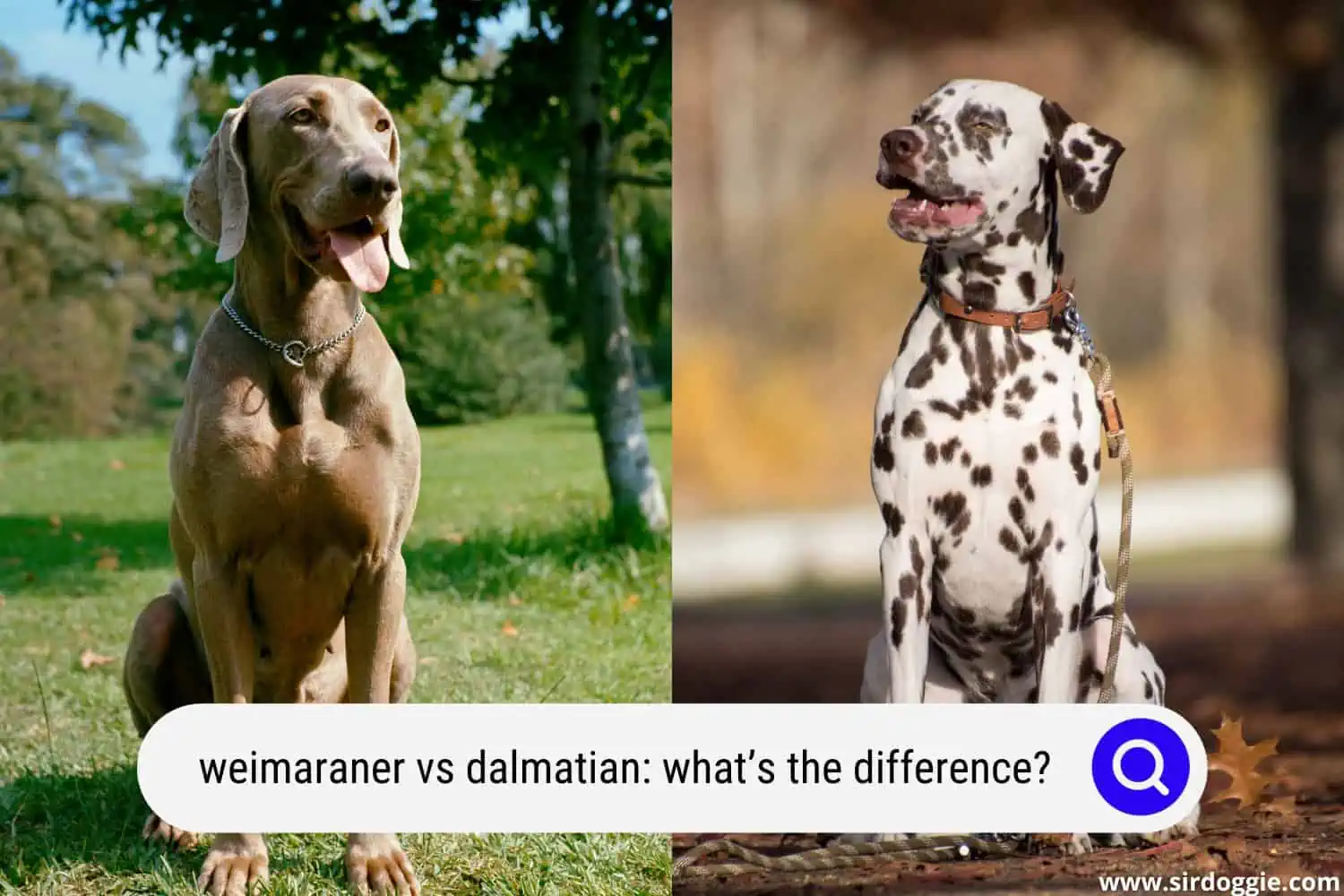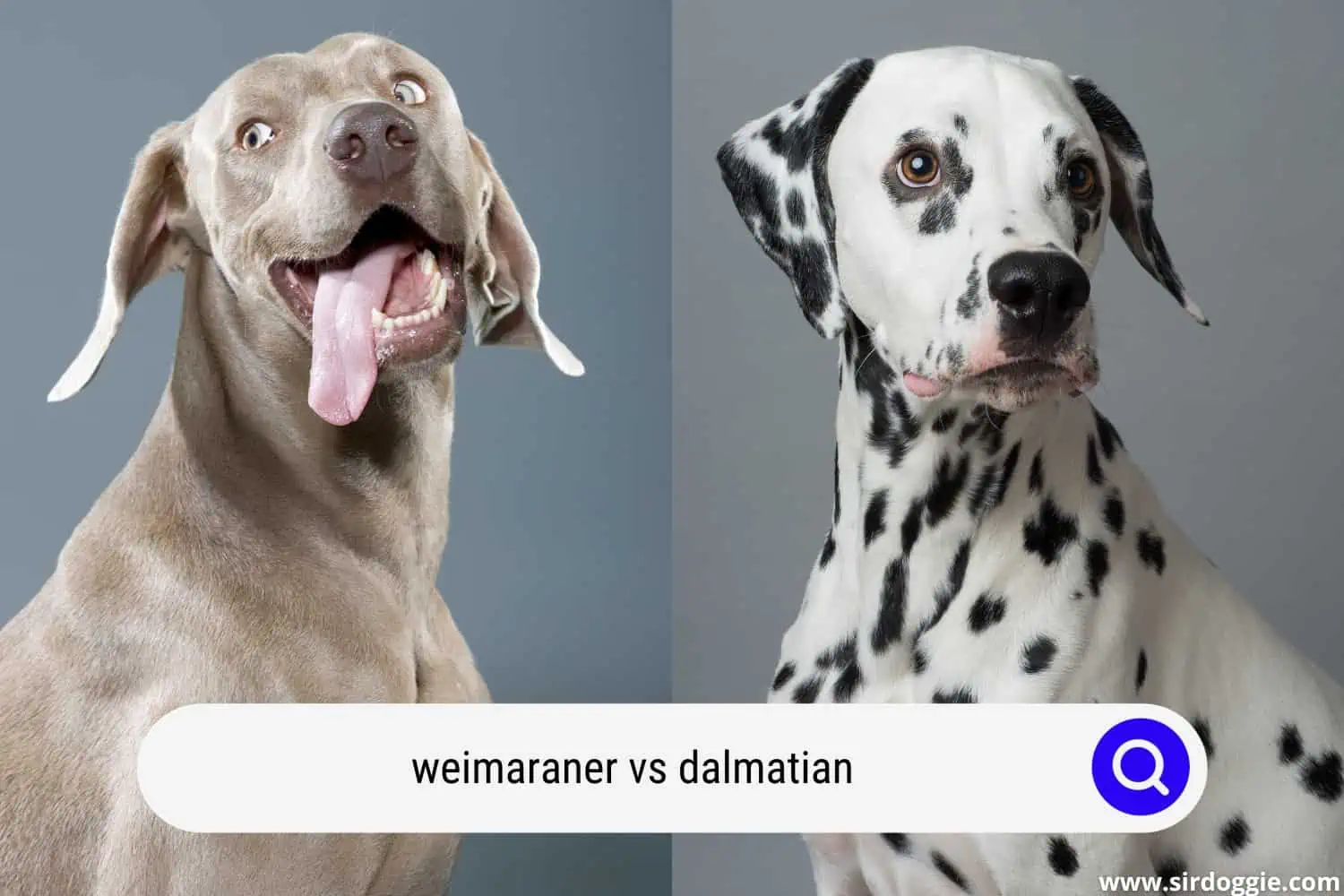Weimaraner vs Dalmatian: What’s the Difference?
The Weimaraner is the dog of the forests: it is a breed with Franco-German origins, suspicious but also of unique tenderness. It is a territorial dog that is predisposed to guarding and defending its family as it becomes attached to its master.

However, the Dalmatian is a dog breed of Croatian origin. It belongs to the group of hounds and blood trail dogs but is also a companion dog.
In this Weimaraner vs Dalmatian comparison article, we will tell you everything about both dog breeds and give you a side-by-side comparison in a chart.
Related Reading: Vizsla vs Dalmatian: What’s the Difference?
The Weimaraner: dog of the forests
Weimaraner origin and history
The Weimaraner is a breed with Franco-German origins. The name of this breed is derived from Weimar and suggests that its origins may be German.
It can be traced back to around the 18th century when there was the Weimar court and when the Grand Duke Carl August strongly wanted to go hunting in the Thuringian Forest. The origin of this breed remains secret because the traces were destroyed as German culture wanted.
However, it seems that Germany was the land of selection but that of origin is France where, during the 13th century, Louis IX returned from a crusade in Africa, bringing with it the gray dog of Saint Louis, the direct ancestor of the Weimaraner, a hunting dog usually living in contact with the master.
The gray dog is depicted in several 1600 paintings by Van Dick and Van Baptiste Oudry.
The Weimaraner is a breed officially recognized in 1897 in Germany. Unfortunately, the war wiped out almost all the specimens that had been bred.
In the 1950s there was a real boom of the Weimaraner in the United States, so much so that it spread as a high-class dog, with good taste and elegance. Figures like Grace Kelly and Eisenhower have had this breed.
Weimaraner characteristics
The Weimaraner has a slender, elongated, and muscular body. It is well-proportioned and has a slender snout with long ears. It has amber eyes and hair like silver. The shades of the color of its hair always vary from gray. There are breeds with long hair and short hair.
There is also a rare version of the blue Weimaraner but it is only found in America. Its bearing is elegant and refined. It is an aristocratic hunting dog. In the past, for this reason, it was accepted within the court.
Another peculiarity of the gray dog is that the puppies have blue eyes and as they grow up, they change color and become amber.
Weimaraner character
The Weimaraner is a territorial dog and is predisposed to guarding and defending its family while it becomes attached to its master.
It is a very suspicious dog but thanks to its attitude to be obedient, it will be easy for you to train it. However, it’s advisable to do this when it is a puppy to get used to socializing with other dogs and people to avoid it becoming an aggressive dog when it grows up.
Good training is also useful in regulating its hunting nature as well as helping it to keep its energy and exuberance in check. Leaving such a dog alone in the house without having been educated could bring you some rude awakening.
The Weimaraner is also a magnificent companion dog, also suitable for other activities such as pet therapy, civil service, agility, control and guard of the territory, etc.
Weimaraner health
The diseases that most affect the Weimaraner are hip dysplasia, stomach twisting, and Von Willebrand disease.
Stomach torsion is a frequent pathology in large dogs. In most cases, it causes the death of the animal in a few hours. Certainly, a very timely intervention could make a difference.
Hip dysplasia relates to improper joint development resulting in cartilage erosion. It causes a lot of pain and great difficulty in movement. An intervention of a veterinarian may be required and in more extreme cases the use of a prosthesis.
The Dalmatian: one of the most loved breeds on the planet
Sometimes it has a somewhat moody character, but it’s never aggressive: we are talking about the Dalmatian, one of the most loved breeds on the planet.
Dalmatian history and origin
The Dalmatian dog breed is from Croatia. It is a hound and blood trail dog but is also a companion dog. It is very famous for its coat with black or brown spots. There are theories that explain the association of the breed with the leopard, due to both animals’ spotted coats.
Based on written references, this dog breed seems to have arrived with the invasions of the Slavic people on the south-eastern coasts. Further on, we can find them on the canvases of 17th-century Flemish painters in the role of hunters.
This is also the role this dog played in the past. In this role, we also see it in Great Britain at the beginning of the 19th century. But not only that. In 1912, the Dalmatians were also trained as “relay dogs” during the Balkan wars.
In recent decades, the Dalmatian has become famous thanks to Walt Disney, who made it the protagonist of the film 101 Dalmatians and its sequel, 101 Dalmatians II. This has been both good and bad for this breed.
A good thing because it managed to make it a well-known and appreciated breed, a bad thing because it was the victim of “commercial” breeders who were concerned about riding trends while not preserving and protecting the breed.
Dalmatian appearance and physical characteristics
A characteristic of this dog breed is the coat which has black or brown spots distributed throughout the body. The general appearance is that of a muscular but well-balanced and elegant dog.
The head is quite long, with a flat and broad skull. The stop is pronounced and the muzzle is long but not pointed. The nose is black in black-spotted dogs and brown in brown-spotted dogs. The Dalmatian’s eyes are round and of medium size. They appear quite distant from each other.
The color is dark brown in subjects with black spots and up to amber in those with brown spots. The ears are of medium length and set high. They are hanging and fall adherent to the head. Wide at the base, they gradually narrow into a rounded tip.
The neck is long and arched, while the chest is not very wide even if it is still deep. The tail has a broad base and tapers at the tip. At rest, it is carried hanging with a slight upward curvature. In movement, it is carried just above the topline but never too high.
The forelegs are straight and sturdy while the hind limbs are muscular and powerful.
Movement is smooth with elongated strides and strong rear propulsion. Overall, the Dalmatian is a very elegant-looking dog breed.
As far as the hair is concerned, it is smooth, short, dense, and appears shiny. As for the coat, the base color is always white while the spots can be black or brown. The spots are round and well-delineated. They are about 2-3 cm in diameter.
Dalmatian Personality
When we are talking about the Dalmatians, we are talking about the canine breed that is synonymous with joy and play. Behind its spots, its elegant and clean bearing hides a real playful spirit.
Behind the elegance hides a canine with a lively, energetic, and playful character. This is a dog that develops a strong possessive and protective attachment towards its owner and family and suffers if separated from them.
The Dalmatian may become restless if not doing enough exercise. It might be unpredictable and moody but it’s never bad.
The ideal would be to take it for long walks. Relegated to the house, the Dalmatian gets bored and irritated thus having a destructive attitude.
Dalmatian average life and pathologies
The Dalmatian has an average life span of 11 years but some specimens easily reach 15 years. It is a robust and healthy breed even if it is subject to some pathologies such as:
- Congenital Deafness: 8% of dogs belonging to this breed are deaf in both ears and 22% are deaf in one ear.
- Autoimmune thyroid: this affects 14.4% of the breed.
- Kidney stones: they are genetically predisposed to them, due to a defect in uric acid metabolism. These issues have led to a major collapse in the Dalmatian population in the United States.
- Hip dysplasia: although it is relatively uncommon, it affects only 4.6% of these dogs.
Furthermore, the Dalmatian does not have an undercoat so it would be good to never expose it to too cold or too hot temperatures.
Weimaraner vs Dalmatian: Side by side comparison
| Weimaraner | Dalmatian | |
| Other names | Raner | 59 to 70 cm in males and 57 to 65 cm in bitches |
| Origin | Germany | Croatia |
| Height | 58 to 61 cm in males and 56 to 58 cm in bitches | 15 to 32 kg in males and 16 to 24 kg in bitches |
| Weight | 30 to 40 kg in males 25 to 35 kg in bitches | 15 to 32 kg in males 16 to 24 kg in bitches |
| Lifespan | 11 to 14 years on average | 12 to 14 years on average |
| Dog type | An all-purpose athletic gun dog used for hunting | Large-sized hunting dog, carriage dog, family dog, and competition dog |
| Character | Stubborn, aloof, intelligent, energetic, and alert | Friendly, intelligent, energetic, outgoing, and playful |

Conclusion
The Weimaraner dog is very sensitive and affectionate. It develops an almost morbid attachment to its owner. The owner must be careful and very patient, consistent in giving rules.
It is an extremely smart and cunning dog that needs a lot of motion so it is not a dog suitable for those who lead a sedentary life.
Meanwhile, the Dalmatian is absolutely beautiful both in and out. Not for nothing is it considered one of the most suitable dogs for playing with children. As moody as it may be, it is light-hearted.

Family Dog Expert Author
Hi there! I’m Stuart, a devoted dog lover and family dog expert with over a decade of experience working with our furry companions. My passion for dogs drives me to share my knowledge and expertise, helping families build strong, loving bonds with their four-legged friends. When I’m not writing for SirDoggie, you’ll find me hiking, playing with my beautiful dog, or studying music.